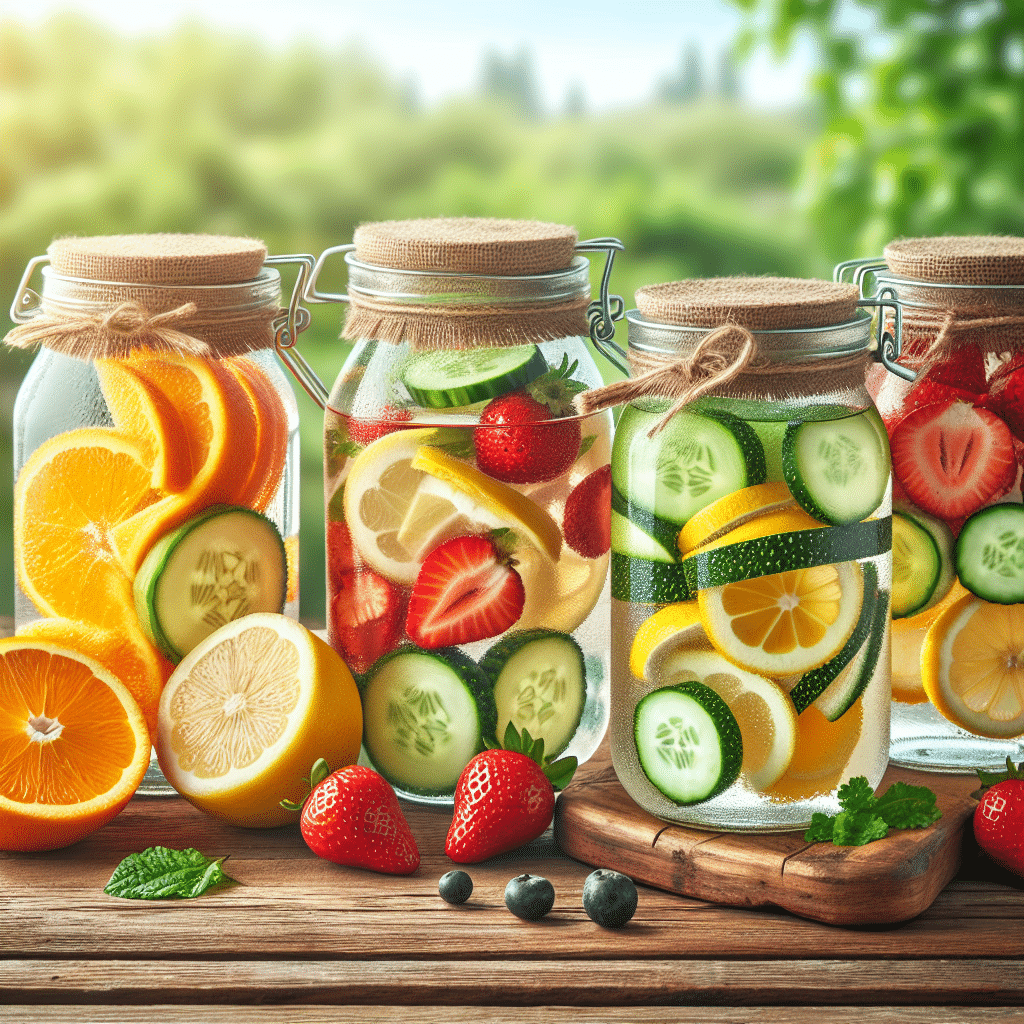Homemade Water Infusions to Boost Hydration Flavor
1. The Basics of Water Infusion
Water infusion is the process of adding fruits, vegetables, herbs, and spices to water, allowing their flavors and nutrients to seep in. This simple method not only enhances taste but also encourages increased fluid intake, which is vital for overall health. Homemade water infusions are customizable, cost-effective, and can significantly improve hydration habits by making water more appealing.
2. Benefits of Hydration
Staying properly hydrated is crucial for various bodily functions, including digestion, circulation, and temperature regulation. Dehydration can lead to fatigue, headaches, and impaired cognitive function. Infused waters can help combat these issues by making water consumption more enjoyable, thus encouraging adherence to daily hydration goals.
3. Choosing Your Ingredients
When creating homemade water infusions, the choice of ingredients is pivotal. Here are some categories of ingredients to consider:
-
Fruits: Berries (strawberries, blueberries, raspberries), citrus (lemons, limes, oranges), melons (watermelon, cantaloupe), and exotic options (pineapple, kiwi, mango) all provide vibrant flavors and essential vitamins.
-
Vegetables: Slices of cucumber, bell peppers, or even tomatoes can impart refreshing tastes and hydration.
-
Herbs: Fresh herbs such as mint, basil, rosemary, and sage add depth and complexity to infused water.
-
Spices: For a kick, consider adding spices like ginger, cinnamon sticks, or vanilla beans.
4. How to Infuse Water
-
Basic Method:
- Start by thoroughly washing your ingredients to remove any pesticides or contaminants.
- Cut fruits and vegetables into small pieces to maximize flavor release.
- Fill a pitcher or jar with filtered water, add your prepared ingredients, and refrigerate for at least 2-4 hours (or overnight for stronger flavors) before serving.
-
Cold Brew: For a more delicate infusion, fill your pitcher with cold water and toss in your ingredients. Allow it to steep in the refrigerator for up to 24 hours.
-
Warm Infusion: If you prefer a warm or hot beverage, heat water and let it steep with your ingredients similarly to brewing tea.
5. Flavor Combinations to Try
-
Citrus and Mint: Combine fresh mint leaves, lemon, and lime slices for a refreshing take on hydration that’s perfect for summer.
-
Berry Bliss: Mix strawberries, blueberries, and basil for a delightful concoction that’s rich in antioxidants.
-
Tropical Paradise: Infuse water with pineapple chunks, mango slices, and coconut for an invigorating, tropical vibe.
-
Cucumber and Rosemary: Crisp cucumber paired with rosemary creates an earthy, refreshing flavor that’s perfect for sipping throughout the day.
-
Spicy Ginger-Lemon: Add slices of fresh ginger and lemon juice for a zesty infusion that offers a soothing effect.
6. Storing and Serving Your Infusions
Always store infused water in an airtight container in the refrigerator to maintain freshness. If using delicate ingredients like berries or herbs, it’s best to consume the infusion within 24-48 hours. When serving, consider adding ice cubes made from the same infusion to keep it cool and visually appealing.
7. Tips for Best Results
-
Experimentation: Feel free to mix and match different fruits, vegetables, and herbs to find your unique blend.
-
Seasonal Ingredients: Use seasonal items for the best flavors and freshness. For example, enjoy winter spices in fall, and focus on summer fruits when they are in peak season.
-
Layering Flavors: Start with base flavors and layer in other ingredients gradually to achieve a balanced infusion.
-
Avoid Sweeteners: Stick to whole ingredients without added sugar or sweeteners to keep your infusion healthy.
8. Nutritional Benefits of Common Ingredients
-
Cucumbers: High water content (about 96%), low in calories, and contain antioxidants that promote hydration and skin health.
-
Lemons: Excellent source of vitamin C, helps with digestion, and may enhance the flavor of other ingredients.
-
Mint: Aids in digestion and adds a refreshingly aromatic note to infused water.
-
Ginger: Known for its anti-inflammatory properties and can aid in digestive health.
9. Hydration Goals and Daily Intake
The National Academies of Sciences, Engineering, and Medicine recommends about 3.7 liters (125 ounces) for men and 2.7 liters (91 ounces) for women daily. Homemade infusions can significantly contribute towards these totals, making consuming adequate fluids less of a chore.
10. Infusions for Wellness
Certain infusions can be tailored for specific wellness goals:
-
Detox Waters: Use ingredients like lemon, cucumber, and ginger to create detoxifying infusions that aid digestion and cleanse the body.
-
Energy Boosters: Incorporate fruits with high natural sugars like apples and bananas, along with spices like cinnamon, for a quick energy lift.
-
Calming Blends: Chamomile tea infused with honey and lemon can serve as a comforting drink before bed, promoting relaxation.
11. Environmental Benefits
Opting for homemade water infusions instead of purchasing bottled flavored water can significantly reduce plastic waste. By creating your own infusions, you contribute to a more sustainable lifestyle while enjoying healthier hydration options.
12. Final Thoughts on Hydration Habits
With the outlined tips and flavor combinations, homemade water infusions provide an exciting and healthy way to boost daily hydration. Exploring flavors and ingredients can enhance your wellness journey, making it easier to drink water throughout the day, encouraging a healthy habit that supports overall health and well-being.
